Surface Deformation Time-Series Monitoring and Stability Analysis of Elevated Bridge Sites in a Coal Resource-Based City
Abstract
:1. Introduction
2. Materials and Methods
2.1. Overview of the Study Area
2.2. Method
3. Results
3.1. Data Selection
3.2. Interferogram Generation
3.3. Phase Unwrapping and Filtering
3.4. Time-Series Deformation Rate
4. Discussion
4.1. March 2019–December 2020 Monitoring Results and Analysis
4.2. January 2021–July 2023 Monitoring Results and Analysis
5. Conclusions
- SBAS-InSAR technology can effectively meet the safety monitoring requirements for elevated bridges in subsidence areas, thereby providing support for the safe operation of elevated bridges in coal-dependent cities.
- During the period from March 2019 to December 2020, the cumulative maximum deformation in the subsidence area of the elevated bridge site was 44 mm and the maximum uplift was 22 mm, indicating a relatively stable site. However, protective measures should be implemented during the construction phase.
- From January 2021 to July 2023, the cumulative maximum deformation in the subsidence area of the elevated bridge site was 10 mm, and the overall site remained stable. This deformation poses no threat to the safe construction and operation of regional elevated bridges.
Author Contributions
Funding
Institutional Review Board Statement
Informed Consent Statement
Data Availability Statement
Conflicts of Interest
References
- Ng, A.H.M.; Liu, Z.; Du, Z.; Huang, H.; Wang, H.; Ge, L. A novel framework for combining polarimetric Sentinel-1 InSAR time series in subsidence monitoring—A case study of Sydney. Remote Sens. Environ. 2023, 295, 113694. [Google Scholar] [CrossRef]
- Song, W.; Liu, J. Study on the utilization of Gob under the transformation condition of coal resource-based cities. In Proceedings of the 2012 China Urban Planning Annual Conference (02. Urban Master Planning), Yunnan, China, 17 October 2012. [Google Scholar]
- Dong, J.; Li, X.; Mei, Y.; Liu, S. Old goaf ground substation site stability of D-InSAR monitoring. J. Min. Saf. Eng. 2022, 33, 62–71. [Google Scholar]
- Ma, S.; Qiu, H.; Yang, D.; Wang, J.; Zhu, Y.; Tang, B.; Sun, K.; Cao, M. Surface multi-hazard effect of underground coal mining. Landslides 2023, 20, 39–52. [Google Scholar] [CrossRef]
- Gagliardi, V.; Tosti, F.; Bianchini Ciampoli, L.; Battagliere, M.L.; D’Amato, L.; Alani, A.M.; Benedetto, A. Satellite Remote Sensing and Non-Destructive Testing Methods for Transport Infrastructure Monitoring: Advances, Challenges and Perspectives. Remote Sens. 2023, 15, 418. [Google Scholar] [CrossRef]
- Xiong, S.; Wang, C.; Qin, X.; Zhang, B.; Li, Q. Time-Series Analysis on Persistent Scatter-Interferometric Synthetic Aperture Radar (PS-InSAR) Derived Displacements of the Hong Kong–Zhuhai–Macao Bridge (HZMB) from Sentinel-1A Observations. Remote Sens. 2021, 13, 546. [Google Scholar] [CrossRef]
- Lan, H.; Li, L.; Liu, H.; Yang, Z. Complex Urban Infrastructure Deformation Monitoring Using High Resolution PSI. IEEE J. Sel. Top. Appl. Earth Obs. Remote Sens. 2012, 5, 643–651. [Google Scholar] [CrossRef]
- Wang, Y.; Zhu, X.; Zeisl, B.; Pollefeys, M. Fusing Meter-Resolution 4-D InSAR Point Clouds and Optical Images for Semantic Urban Infrastructure Monitoring. IEEE Trans. Geosci. Remote Sens. 2017, 55, 14–26. [Google Scholar] [CrossRef]
- Chen, Y.; Dong, X.; Qi, Y.; Huang, P.; Sun, W.; Xu, W.; Tan, W.; Li, X.; Liu, X. Integration of DInSAR-PS-Stacking and SBAS-PS-InSAR Methods to Monitor Mining-Related Surface Subsidence. Remote Sens. 2023, 15, 2691. [Google Scholar] [CrossRef]
- Ferretti, A.; Prati, C.; Rocca, F. Permanent scatterers in SAR interferometry. IEEE Trans. Geosci. Remote Sens. 2001, 39, 8–20. [Google Scholar] [CrossRef]
- Sun, M.; Du, Y.; Liu, Q.; Feng, G.; Peng, X.; Liao, C. Understanding the Spatial-Temporal Characteristics of Land Subsidence in Shenzhen under Rapid Urbanization Based on MT-InSAR. IEEE J. Sel. Top. Appl. Earth Obs. Remote Sens. 2023, 16, 4153–4166. [Google Scholar] [CrossRef]
- Baltiyeva, A.; Orynbassarova, E.; Zharaspaev, M.; Akhmetov, R. Studying sinkholes of the earth’s surface involving radar satellite interferometry in terms of Zhezkazgan field, Kazakhstan. Min. Miner. Depos. 2023, 17, 61–74. [Google Scholar] [CrossRef]
- Hendrix, R.; Ooi, P. Interferometric Synthetic Aperture Radar versus Inclinometer Ground Surface Deformations at Active Landslide. Transp. Res. Rec. 2023, 2677, 736–747. [Google Scholar] [CrossRef]
- Necsoiu, M.; Mcginnis, R.N.; Hooper, D.M. New insights on the Salmon Falls Creek Canyon landslide complex based on geomorphological analysis and multitemporal satellite InSAR techniques. Landslides 2014, 11, 1141–1153. [Google Scholar] [CrossRef]
- Li, F.; Liu, G.; Gong, H.; Chen, B.; Zhou, C. Assessing Land Subsidence-Inducing Factors in the Shandong Province, China, by Using PS-InSAR Measurements. Remote Sens. 2022, 14, 2875. [Google Scholar] [CrossRef]
- Ou, W.; Zhao, B.; Zhi, Y.; Fei, X.; Ma, X.; Yang, G. Research on Displacement Monitoring Technique for Goaf along Power Transmission Line Based on GF-3 Satellite Data. In Proceedings of the International Conference on Information Science and Control Engineering (ICISCE), Shanghai, China, 20–22 December 2019. [Google Scholar]
- Chen, Y.; Yu, S.; Tao, Q.; Liu, G.; Wang, L.; Wang, F. Accuracy Verification and Correction of D-InSAR and SBAS-InSAR in Monitoring Mining Surface Subsidence. Remote Sens. 2021, 13, 4365. [Google Scholar] [CrossRef]
- Li, Y.; Yang, K.; Zhang, J.; Hou, Z.; Wang, S.; Ding, X. Research on time series InSAR monitoring method for multiple types of surface deformation in mining area. Nat. Hazards 2022, 114, 2479–2508. [Google Scholar] [CrossRef]
- Zheng, M.; Guo, Q.; Zhao, R.; Wang, L.; Huang, Y. Surface subsidence disasters over Xuzhou city, China 2014–2018 revealed by InSAR and Peck model. Environ. Earth Sci. 2023, 82, 264. [Google Scholar]
- Cusson, D.; Trischuk, K.; Hébert, D.; Hewus, G.; Gara, M.; Ghuman, P. Satellite-Based InSAR Monitoring of Highway Bridges: Validation Case Study on the North Channel Bridge in Ontario, Canada. Transp. Res. Rec. 2018, 2672, 76–86. [Google Scholar] [CrossRef]
- Zhang, Z.; Wang, M.; Liu, X.; Wang, C.; Zhang, H.; Tang, Y.; Zhang, B. Deformation Feature Analysis of Qinghai–Tibet Railway Using TerraSAR-X and Sentinel-1A Time-Series Interferometry. IEEE J. Sel. Top. Appl. Earth Obs. Remote Sens. 2019, 12, 5199–5212. [Google Scholar] [CrossRef]
- Wang, N.; Dong, J.; Wang, Z.; Lei, J.; Zhang, L.; Liao, M. Monitoring Large-Scale Hydraulic Engineering Using Sentinel-1 InSAR: A Case Study of China’s South-to-North Water Diversion Middle Route Project. IEEE J. Sel. Top. Appl. Earth Obs. Remote Sens. 2022, 15, 739–750. [Google Scholar] [CrossRef]
- Qin, X.; Li, Q.; Ding, X.; Xie, L.; Wang, C.; Liao, M.; Zhang, L.; Zhang, B.; Xiong, S. A structure knowledge-synthetic aperture radar interferometry integration method for high-precision deformation monitoring and risk identification of sea-crossing bridges. Int. J. Appl. Earth Obs. Geoinf. 2021, 103, 102476. [Google Scholar] [CrossRef]
- Tao, W.; Dai, L.; Zhang, Z.; Tang, B.; Yu, L. Stability Analysis Model of Expressway Passing through Goaf Based on SBAS-InSAR Technology. Math. Probl. Eng. 2022, 2022, 7006464. [Google Scholar] [CrossRef]
- Kinoshita, K.; Kumura, T.; Yamaguchi, Y.; Tanaka, T. Anomalous Displacement Detection of Bridges Using Satellite SAR: A Case Study on a Collapse of Musota Water Pipe Bridge. In Proceedings of the IGARSS 2023—2023 IEEE International Geoscience and Remote Sensing Symposium, Pasadena, CA, USA, 16–21 July 2023; pp. 1720–1723. [Google Scholar]
- Wang, Z.; Zhang, J.; Huang, G. Precise monitoring and analysis of the land subsidence in Jining coal mining area based on InSAR technique. J. China Univ. Min. 2014, 43, 169–174. [Google Scholar]
- Guo, S.; Ji, Y.; Tian, X.; Zhang, W.; Kang, W.; Li, Y.; Zhang, T. Deformation Velocity Monitoring in Kunming City using Ascending and Descending Sentinel-1A Data with SBAS-InSAR Technique. In Proceedings of the IGARSS 2020—2020 IEEE International Geoscience and Remote Sensing Symposium, Waikoloa, HI, USA, 26 September–2 October 2020; pp. 1993–1996. [Google Scholar]
- Xu, Y.; Li, T.; Tang, X.; Zhang, X.; Fan, H.; Wang, Y. Research on the Applicability of DInSAR, Stacking-InSAR and SBAS-InSAR for Mining Region Subsidence Detection in the Datong Coalfield. Remote Sens. 2022, 14, 3314. [Google Scholar] [CrossRef]
- Berardino, P.; Fornaro, G.; Lanari, R.; Sansosti, E. A new algorithm for surface deformation monitoring based on Small Baseline Differential SAR Interferograms. IEEE Trans. Geosci. Remote Sens. 2002, 40, 2375–2383. [Google Scholar] [CrossRef]
- Dong, S.; Samsonov, S.; Yin, H.; Ye, S.; Cao, Y. Time-series analysis of subsidence associated with rapid urbanization in Shanghai, China measured with SBAS InSAR method. Environ. Earth Sci. 2014, 72, 677–691. [Google Scholar] [CrossRef]
- Wegmuller, U.; Werner, C.; Strozzi, T. SAR interferometric and differential interferometric processing chain. In Proceedings of the Sensing and Managing the Environment 1998 IEEE International Geoscience and Remote Sensing. Symposium, Seattle, WA, USA, 6–10 July 1998. [Google Scholar]
- Hooper, A.; Zebker, H.; Segall, P.; Kampes, B. A new method for measuring deformation on volcanoes and other natural terrains using InSAR persistent scatterers. Geophys. Res. Lett. 2004, 31. [Google Scholar] [CrossRef]
- Hooper, A.; Segall, P.; Zebker, H. Persistent scatterer interferometric synthetic aperture radar for crustal deformation analysis with application to Volcán Alcedo Galápagos. J. Geophys. Res. 2007, 112. [Google Scholar] [CrossRef]
- Du, Y.; Liu, L.; Feng, G.; Peng, X.; Liang, H.; Zhu, Y. Time-Series Landslide Monitoring Based on Stamps-Sbas: A Case Study in Lushan, Taiwan. In Proceedings of the IEEE International Geoscience and Remote Sensing Symposium, Yokohama, Japan, 28 July–2 August 2019; pp. 9622–9625. [Google Scholar]
- Vajedian, S.; Motagh, M.; Nilfouroushan, F. StaMPS Improvement for Deformation Analysis in Mountainous Regions: Implications for the Damavand Volcano and Mosha Fault in Alborz. Remote Sens. 2015, 7, 8323–8347. [Google Scholar] [CrossRef]

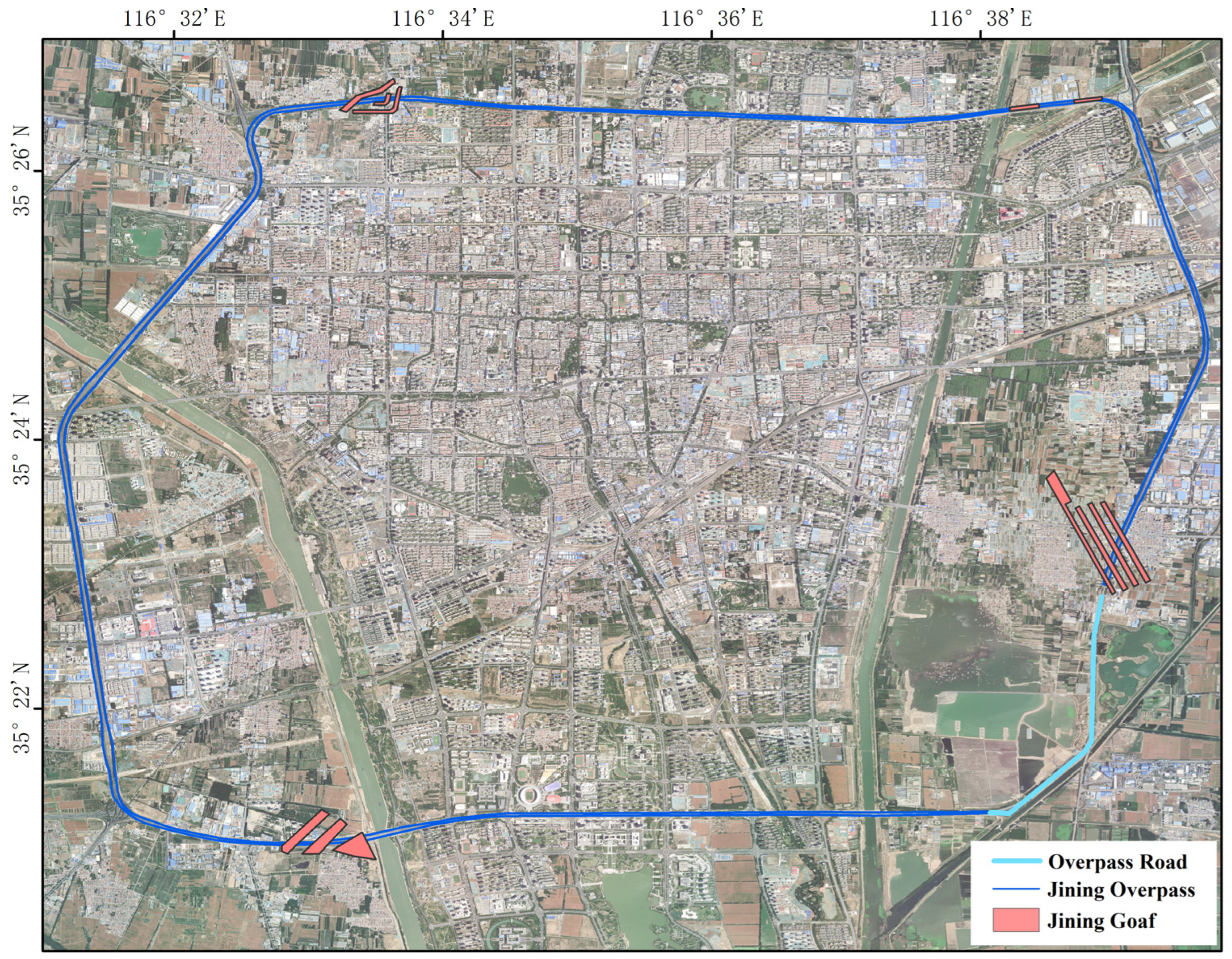
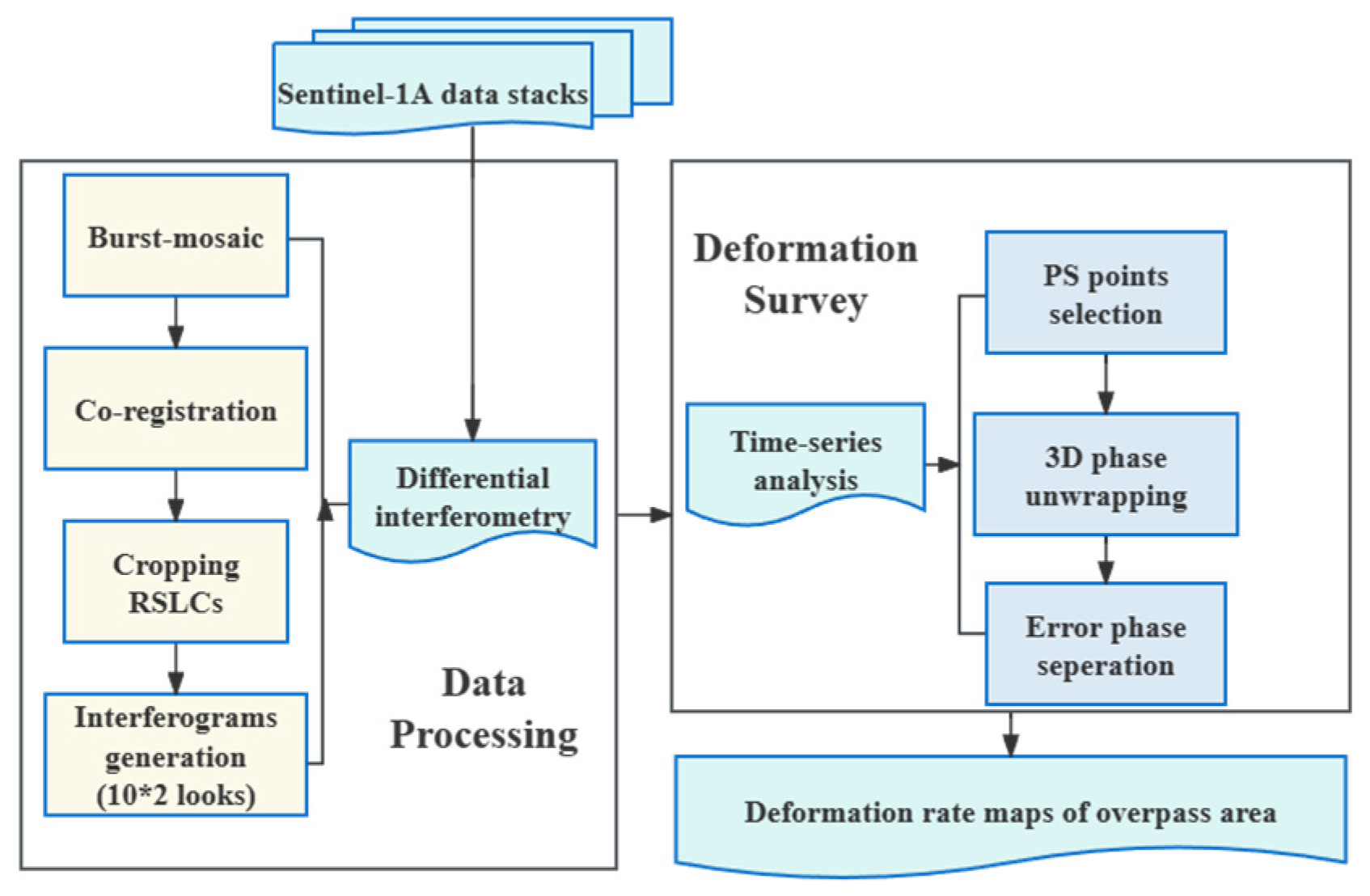


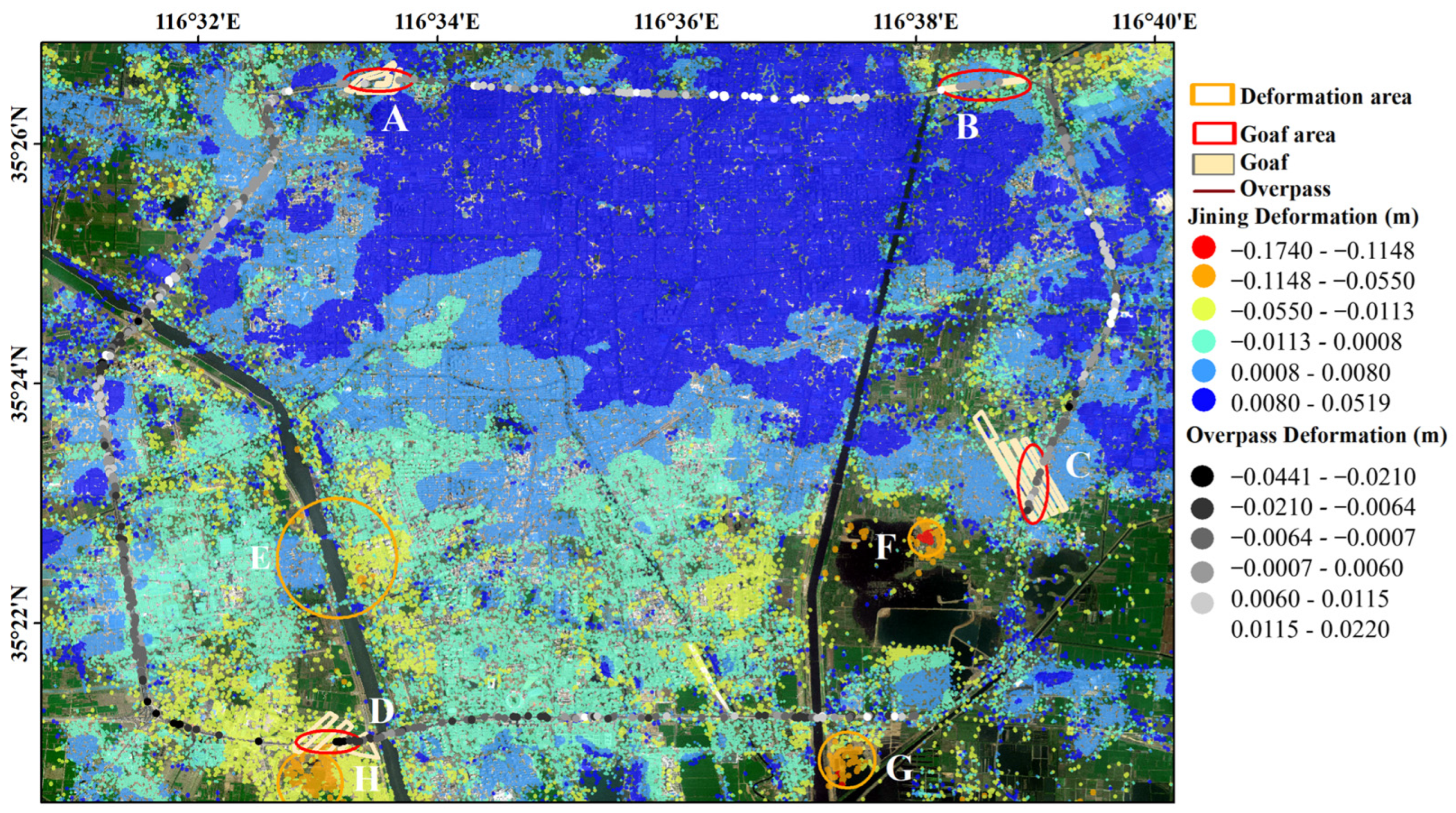




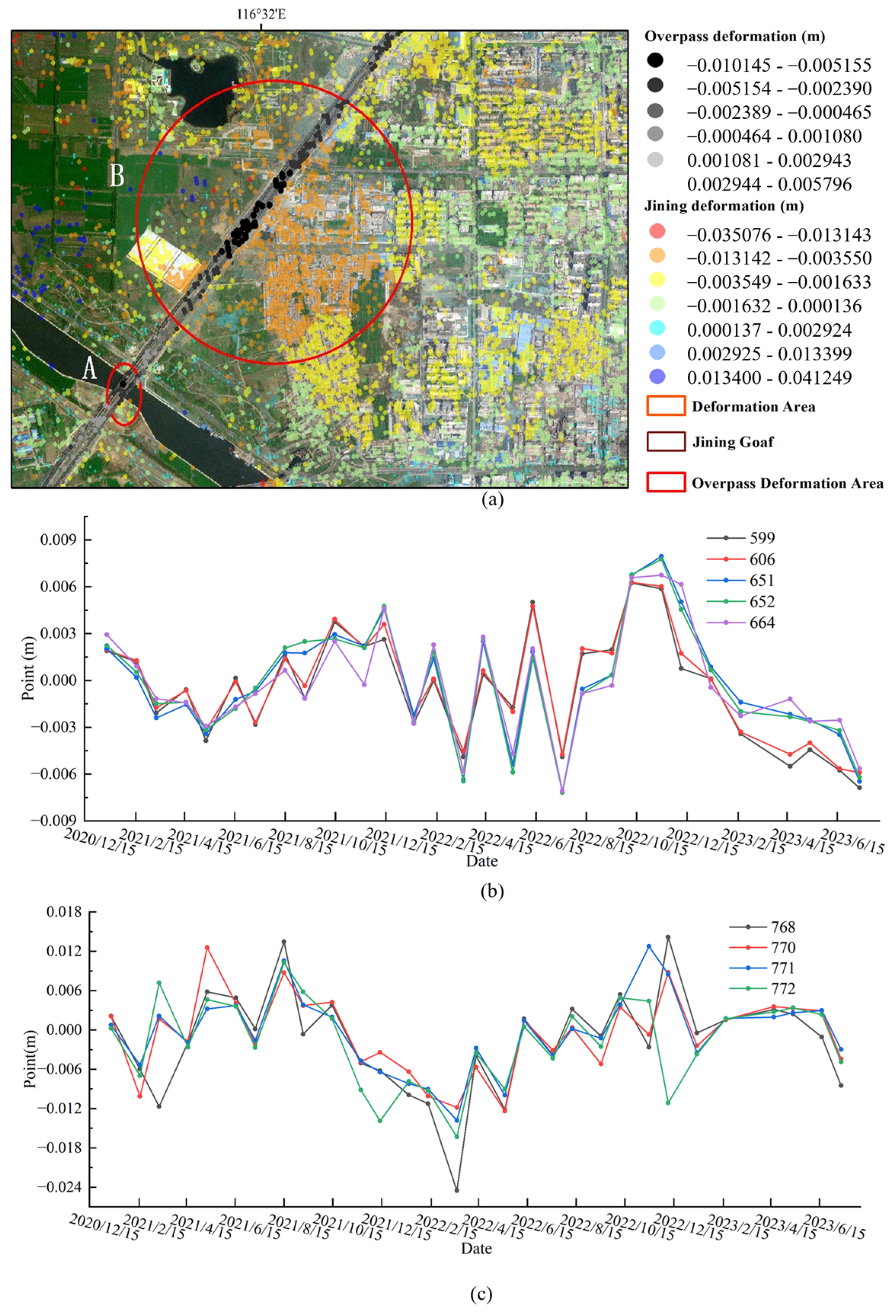
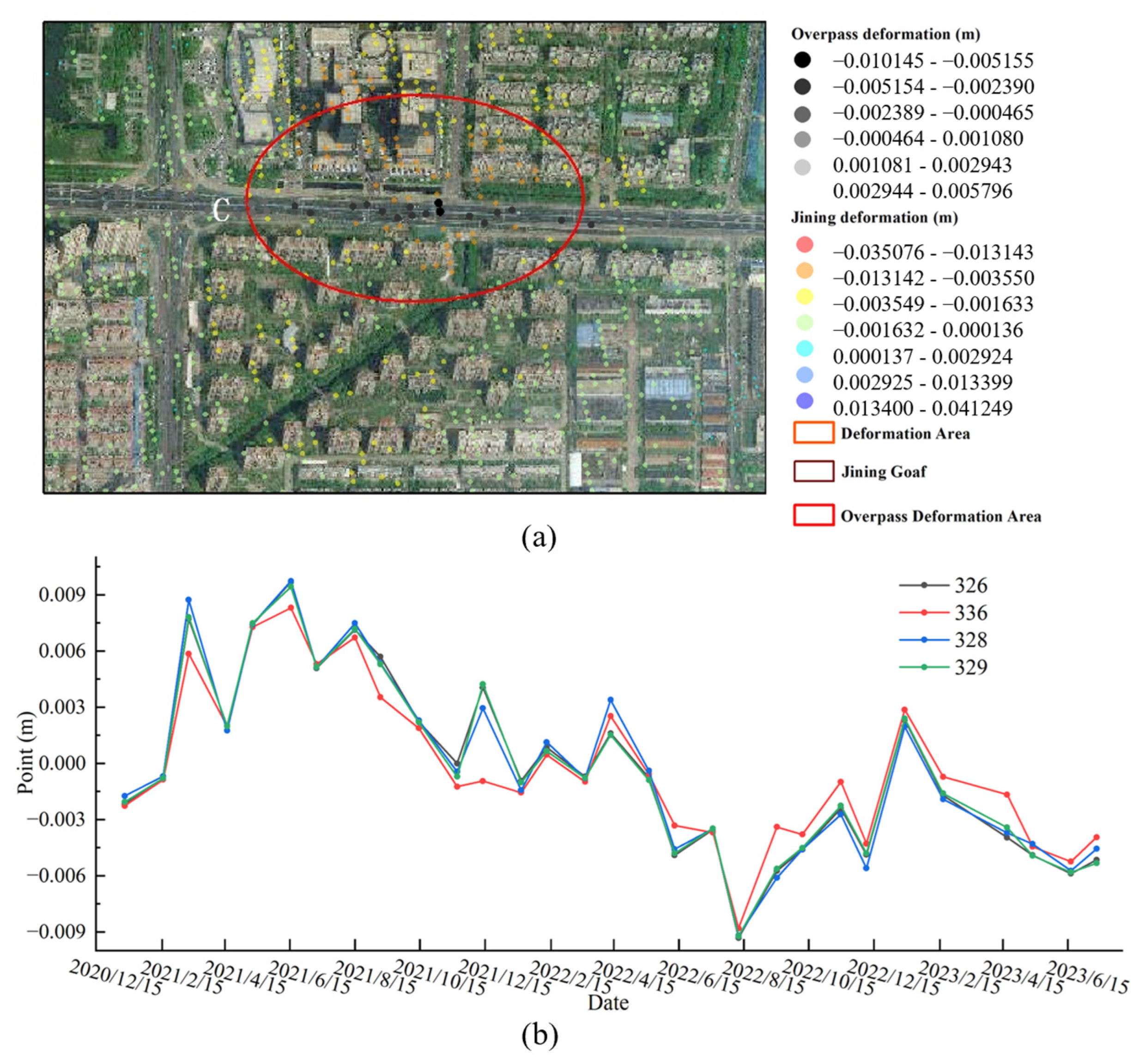

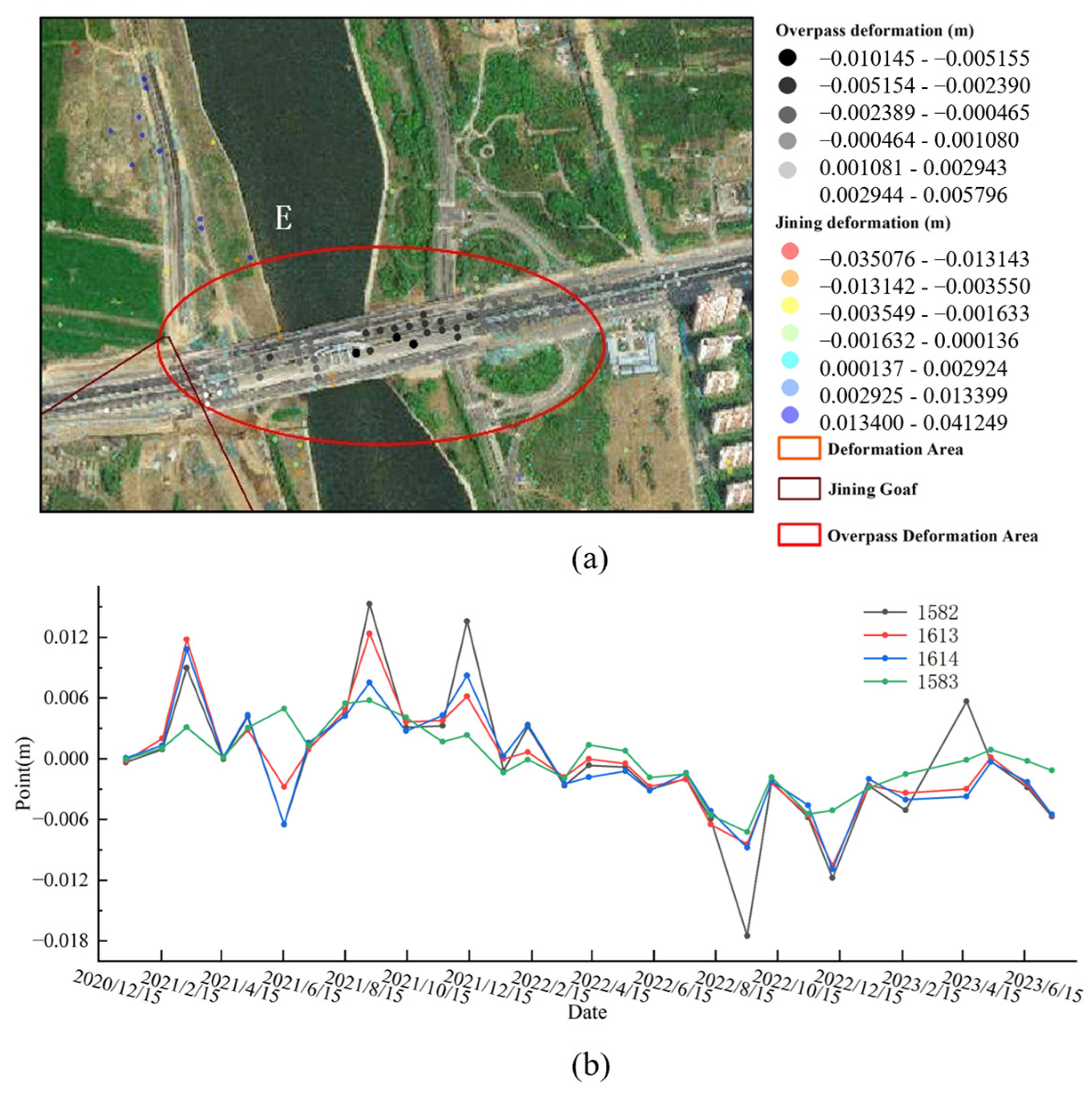

| Number | Imaging Date | Orbit | Number | Imaging Date | Orbit |
|---|---|---|---|---|---|
| 1 | 23 March 2019 | Ascending | 12 | 10 February 2020 | Ascending |
| 2 | 28 April 2019 | Ascending | 13 | 17 March 2020 | Ascending |
| 3 | 22 May 2019 | Ascending | 14 | 10 April 2020 | Ascending |
| 4 | 27 June 2019 | Ascending | 15 | 16 May 2020 | Ascending |
| 5 | 21 July 2019 | Ascending | 16 | 21 June 2020 | Ascending |
| 6 | 26 August 2019 | Ascending | 17 | 15 July 2020 | Ascending |
| 7 | 19 September 2019 | Ascending | 18 | 20 August 2020 | Ascending |
| 8 | 25 October 2019 | Ascending | 19 | 13 September 2020 | Ascending |
| 9 | 18 November 2019 | Ascending | 20 | 19 October 2020 | Ascending |
| 10 | 14 December 2019 | Ascending | 21 | 12 November 2020 | Ascending |
| 11 | 17 January 2020 | Ascending | 22 | 30 December 2020 | Ascending |
| Number | Imaging Date | Orbit | Number | Imaging Date | Orbit |
|---|---|---|---|---|---|
| 1 | 11 January 2021 | Ascending | 17 | 18 May 2022 | Ascending |
| 2 | 16 February 2021 | Ascending | 18 | 11 June 2022 | Ascending |
| 3 | 12 March 2021 | Ascending | 19 | 17 July 2022 | Ascending |
| 4 | 17 April 2021 | Ascending | 20 | 10 August 2022 | Ascending |
| 5 | 11 May 2021 | Ascending | 21 | 15 September 2022 | Ascending |
| 6 | 16 June 2021 | Ascending | 22 | 09 October 2022 | Ascending |
| 7 | 10 July 2021 | Ascending | 23 | 14 November 2022 | Ascending |
| 8 | 15 August 2021 | Ascending | 24 | 08 December 2022 | Ascending |
| 9 | 08 September 2021 | Ascending | 25 | 13 January 2023 | Ascending |
| 10 | 14 October 2021 | Ascending | 26 | 18 February 2023 | Ascending |
| 11 | 19 November 2021 | Ascending | 27 | 14 March 2023 | Ascending |
| 12 | 13 December 2021 | Ascending | 28 | 19 April 2023 | Ascending |
| 13 | 18 January 2022 | Ascending | 29 | 13 May 2023 | Ascending |
| 14 | 11 February 2022 | Ascending | 30 | 18 June 2023 | Ascending |
| 15 | 19 March 2022 | Ascending | 31 | 12 July 2023 | Ascending |
| 16 | 12 April 2022 | Ascending |
Disclaimer/Publisher’s Note: The statements, opinions and data contained in all publications are solely those of the individual author(s) and contributor(s) and not of MDPI and/or the editor(s). MDPI and/or the editor(s) disclaim responsibility for any injury to people or property resulting from any ideas, methods, instructions or products referred to in the content. |
© 2024 by the authors. Licensee MDPI, Basel, Switzerland. This article is an open access article distributed under the terms and conditions of the Creative Commons Attribution (CC BY) license (https://creativecommons.org/licenses/by/4.0/).
Share and Cite
Li, H.; Li, H.; Chen, Y.; Yuan, Y.; Gao, Y.; Li, S.; Guo, G. Surface Deformation Time-Series Monitoring and Stability Analysis of Elevated Bridge Sites in a Coal Resource-Based City. Sustainability 2024, 16, 6115. https://doi.org/10.3390/su16146115
Li H, Li H, Chen Y, Yuan Y, Gao Y, Li S, Guo G. Surface Deformation Time-Series Monitoring and Stability Analysis of Elevated Bridge Sites in a Coal Resource-Based City. Sustainability. 2024; 16(14):6115. https://doi.org/10.3390/su16146115
Chicago/Turabian StyleLi, Hongjia, Huaizhan Li, Yu Chen, Yafei Yuan, Yandong Gao, Shijin Li, and Guangli Guo. 2024. "Surface Deformation Time-Series Monitoring and Stability Analysis of Elevated Bridge Sites in a Coal Resource-Based City" Sustainability 16, no. 14: 6115. https://doi.org/10.3390/su16146115






